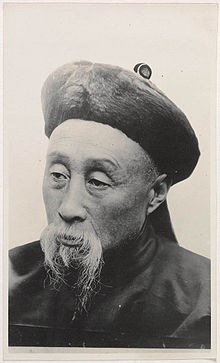Zhao Erfeng
Zhao Erfeng ( Chinese 趙爾豐 / 赵尔丰 , W.-G. Chao Erh-feng ; * 1845 ; † 1911 ), zi : 季 和, was a Qing official and Chinese banners who belonged to the Blue Banner . As a general, supported by imperial troops, Zhao established a tyranny in eastern Tibet in 1906 and laid the basis for the military occupation of all of Tibet in 1910.
Zhao Erfeng was a younger brother of Zhao Erxun .
Soon after the flight of the 13th Dalai Lama into Mongolian exile in 1904 and after the end of the British Tibet campaign and the Russo-Japanese War , the Chinese Empire gained new leeway to consolidate its power in the outskirts of the empire, including Tibet .
In 1905, an attempt by an Amban to intervene in the monastery's autonomy in Eastern Tibet and to expel most of the monks from Bathang Monastery had led to bloody unrest and brought General Zhao Erfeng to the scene. In 1906 he let troops march against other monasteries, plundered them, in some cases literally slaughtered monks and thus became the most hated man in Tibet. In 1907 he occupied the southern Kham militarily and requisitioned most of the grain supplies from the local population without compensation. In 1908 he reinforced his troops and prepared to march into central Tibet . A protest by the Tibetan government against this military action failed because the Ambans refused to forward this protest to the imperial government. Rather, the troops were reinforced and advanced, albeit under the command of another general, the Manchu Zhongyin, on Lhasa .
Zhao Erfeng was one of the earliest victims of the Chinese revolution in October 1911. He was sentenced to death and executed.
literature
- Samuel Adrian M. Adshead: Province and politics in late imperial China. Viceregal government in Szechwan, 1898-1911. Curzon Press, London et al. 1984, ISBN 0-7007-0165-6 , ( Scandinavian Institute of Asian Studies monograph series 50).
- Karl-Heinz Golzio, Pietro Bandini: The fourteen rebirths of the Dalai Lama. The rulers of Tibet - how they come back, how they are found, what they have left behind . OW Barth, Bern et al. 1997, ISBN 3-502-61002-9 .
Web links
| personal data | |
|---|---|
| SURNAME | Zhao, Erfeng |
| ALTERNATIVE NAMES | 赵尔丰 (simplified Chinese); 趙爾豐 (traditional Chinese); Chao Erh-fang (Wade-Giles) |
| BRIEF DESCRIPTION | Chinese official |
| DATE OF BIRTH | 1845 |
| DATE OF DEATH | 1911 |
